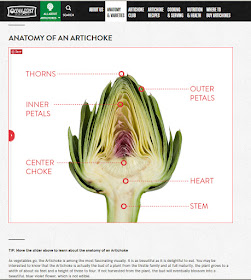 |
| Screenshot of Anatomy of an Artichoke on the Ocean Mist website. Screenshot by Botanicalaccuracy.com, 29 Nov 2016 (fair use). |
Unfortunately, the botanical facts about the artichoke head are not anatomically correct.
The text states:
"You may be interested to know that the Artichoke is actually the bud of a plant from the thistle family and at full maturity, the plant grows to a width of about six feet and a height of three to four. If not harvested from the plant, the bud will eventually blossom into a beautiful, blue-violet flower, which is not edible. The bud contains the Heart, the delightful, meaty core of the Artichoke, and is topped by a fuzzy center, or choke, which is surrounded by rows of petals, which protect the Artichoke Heart. With their tiny thorns, the Artichoke’s petals reveal their thistle heritage."The artichoke is indeed a type of giant thistle, and if you let it flower it will open up to show a flower head similar to thistles, just much larger. But note the word HEAD, which is used for flower arrangements (inflorescences) that have tightly packed and unstalked flowers.
The thistles are part of the sunflower family, the Asteraceae, which is also the home of dandelions, marigolds, tarragon, mugwort, chicory, lettuce, chrysanthemum, and dahlias. All of the species in this family have tiny flowers collected in a cup- or saucer-like head (capitulum), that is surrounded on the lower side by bracts (modified small leaves). The flowers are small and tightly packed, often with tubular narrow (disc) flowers in the center and sometimes with longer, flattened (ray) flowers along the edge, like in a sunflower. One group of species have only ray flowers, like in dandelions. In thistles, there are only tubular disc flowers, and the bracts are long and initially covers the whole sides and top of the head.
So, in their effort to educate the public about the fascinating anatomy of the floral heads of artichokes, Ocean Mist Farms manages to really mix things up. Here is the corrected version of their image:
 |
| Corrected version of the screenshot of Anatomy of an Artichoke, original from Ocean Mist Farms. Modified image by Botanicalaccuracy.com. (fair use, cc-by) |
Their text should read something like this instead:
"You may be interested to know that the Artichoke is actually the YOUNG FLOWER HEAD of a plant from the thistle family and at full maturity, the plant grows to a width of about six feet and a height of three to four. If not harvested from the plant, the HEAD will eventually blossom into a FLOWER HEAD WITH beautiful, blue-violet flowerS, which ARE not edible. The HEAD contains the Heart, the delightful, meaty core of the Artichoke, and is topped by a fuzzy center OF YOUNG FLOWERS, or choke, which is surrounded by rows of BRACTS, which protect the Artichoke Heart. With their tiny SPINES, the Artichoke’s BRACTS reveal their thistle heritage."It is not too late to learn and this is not an uncommon mistake in the food world. Hopefully they fix this information soon. If you want to dig deeper into the anatomy of artichokes, I recommend this post on the Botanist in the Kitchen blog.
(Thanks to RO for sending me this example of botanical inaccuracies in commercial products and companies.)
